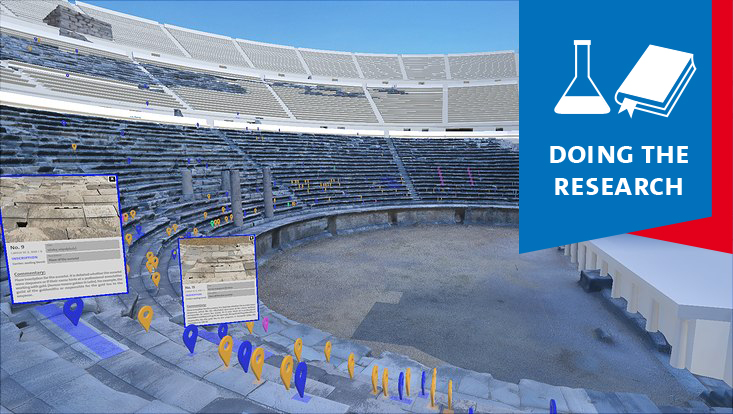Ancient inscriptions“Virtual reality is a perfect instrument for our archaeological approach.”Doing the Research series
23 November 2022, by Viola Griehl

Photo: UWA-Projekt Immersive City Scripts, Jenny Gabel
Miletus was one of the most important cities of classical antiquity. Research, headed by Prof. Dr. Christof Berns from the Archaeological Institute, is being conducted on the ruins, roughly 80 kilometers from Izmir. Berns is interested in the use and appropriation of the city by diverse social groups. One key to understanding this is the inscriptions from the imperial period (31 BCE– 312 CE). And virtual reality also plays an important role.
Prof. Berns, why did people in ancient time scribble on the walls?
In fact, the ancients used any and everything to write on: walls, cobblestones, or the pedestals beneath statues, but also everyday objects. Inscriptions were really a ubiquitous medium of public communication. What is especially interesting is that they were used by very different people and in very different contexts. There are very official documents for the public honoring of a person or publications of the emperor’s letters, but also very brief naming documents to permanently mark seats in the theater and much more. We often find non-linguistic drawings, for example, sidewalks with squares scratched into them to mark a playing field. Overall, inscriptions reveal a very broad range of activity.
If we look at their distribution throughout the urban space, then we can recognize, among other things, the political significance of a particular area due to the density of public documents being published. We are investigating this in a project in our Cluster of Excellence Understanding Written Artefacts.
Who could even read and act accordingly?
We cannot say exactly. But the variety of possible activities to which the inscriptions attest suggest that a large number of city residents could at least understand simple texts. Even official inscriptions are not necessarily formulated in complicated ways. Their structure is largely standardized and they always use the same vocabulary. Furthermore, they were often used to supplement other media.
A typical case is the so-called “honorary monument.” You can imagine a statue portraying a person on a pedestal that bore an inscription. Thus, there was already a kind of memorial monument to honor a specific person. It was sufficient to recognize the name to know for whom the distinction was intended. Only those who wanted to know more and, for example, find out what circumstances led to the honor needed to be able to read a bit more Greek.

To what extent did virtual reality help you better understand the meaning of the inscriptions?
Virtual reality is the perfect instrument for our archaeological approach because space is central to the understanding of inscriptions—whereas earlier, inscriptions were understood and examined more as a specific genre. But even just the inscribing of letters into stone makes them plastic objects and the written monument is also 3-dimensional. And finally, the placement of an inscription in the urban space impacts its message. Standard tools such as maps and photos are insufficient for recording all of this.
Using virtual reality, we can move throughout the entire structure and directly experience the effect of the inscriptions.
In a first step, it was primarily the doctoral researchers Jenny Gabel (informatics) and Lauren Osthof (archaeology / ancient history) who developed a virtual reality model of the Miletus theater. With this aid, we can move through the entire structure and experience the effect of the many inscriptions directly and what relationship they had to one another. We can also populate the virtual reality model with avatars, or abstract images of people, to determine how the activities in relation to the inscriptions shaped public space.
And what did you find out about the meaning of these inscriptions in public space?
Lauren Osthof arduously documented all fixed inscriptions in Miletus, including numerous game squares mentioned above and that had previously attracted little attention. A fascinating result of this work is the discovery that leisure in imperial Miletus was a very present phenomenon. You can specially find such squares on the margins of public squares, on the steps of public monuments, or in the entryways of buildings. Virtual reality makes very visible how much we need to see urban space in some areas as highly dominated by people who spent time sitting and playing. Natrually, this creates a different view of the ancient city; one that is not just seen as unused architecture.
You were named to head the excavation by the Turkish ministry of cultural affairs. What is the significance of the excavation for Turkey and how do you work together with your Turkish colleagues?
The excavation is very significant in Turkey. This has to do with the fact that Miletus, which reaches back to the end of the fourth century BCE and extends to the fifteenth century CE, is a significant historical location. Furthermore, the excavation itself is full of tradition, because Berlin museums already initiated it in 1899. I am therefore even more grateful to the Turkish Directorate-General for Antiquities and Museums for trusting me with overseeing the excavation. We are working closely with colleagues and students from Istanbul’s Mimar Sinan University and also with the local museum. In the last few years, the excavation has also grown into more of an international project. Most recently, we were able to offer a summer school program for Turkish students, thanks to support from DAAD. It is especially nice that such cooperation often leads to further connections, for example, student or researchers exchanges.
Project
The Miletus excavation is being conducted by Universität Hamburg (Institute of Archaeology and Cultural History of the Ancient Mediterranean) with the permission of the Directorate-General for Cultural Goods and Museums in Turkey and in cooperation with the Mimar Sinan Güzel Sanatlar Üniversitesi Istanbul and the École normale supérieure Paris. It is being funded by the German Research Foundation and the Agence Nationale de la Recherche. Immersive City Scripts: Inscriptions and the Construction of Social Spaces in Miletus (Asia Minor), a project headed by Prof. Dr. Christof Berns (classical archaeology), Prof Dr. Kaja Harter-Uibopuu (ancient history), and Prof. Dr. Frank Steinicke (human-computer interaction), is being funded in the context of the Cluster of Excellence Understanding Written Artefacts. Current staff: Jenny Gabel, Nathalie Martin, Lauren Osthof The pohtogrammetry lab at the Berlin College of Technology (Prof. Ing. Michael Breuer, Felix Neupert, and Johannes Neis) contributed to the 3D documentation of the theater.
Doing the Research
There are approximately 6200 academics conducting research at 8 faculties at Universität Hamburg. Many students also often apply their newly acquired knowledge to research practice while still completing their studies. The Doing the Research series outlines the broad and diverse range of the research landscape, and provides a more detailed introduction of individual projects. Feel free to send any questions and suggestions to the Newsroom editorial office(newsroom"AT"uni-hamburg.de).



